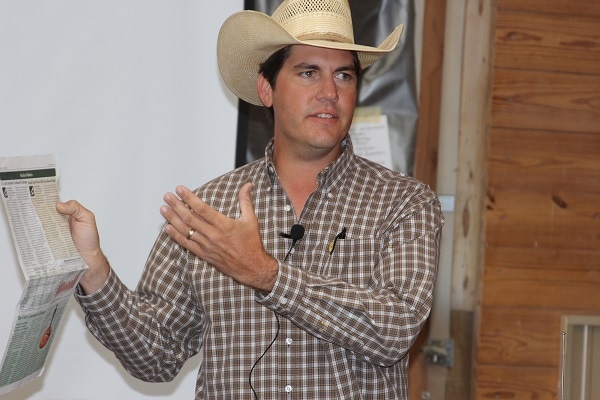June 5, 2014

Lipscomb County, Texas rancher Clay Cooper is the first Texas producer to sign a conservation plan through the USDA-Natural Resources Conservation Service (NRCS) Working Lands for Wildlife (WLFW) partnership, an agreement with the Department of Interior United States Fish and Wildlife Service (USFWS).
Cooper and other producers partnering with NRCS, are taking advantage of a workable and economically viable solution that will enhance and help protect the lesser prairie-chicken habitat.
The new cooperative conservation effort is a voluntary program.
Cooper and other producers will receive assurances for up to 30 years exempting them from any incidental take of the lesser prairie-chicken to implement and maintain conservation practices in a conservation plan. WLFW participants can proceed with planned activities knowing they are assured coverage of potential incidental take of the lesser prairie-chicken.
“NRCS has trained professionals with skills and guidance I needed,” says Cooper. “They are not the Big Bad Wolf.”
For the latest on southwest agriculture, please check out Southwest Farm Press Daily and receive the latest news right to your inbox.
Essentially, a landowner or producer with land in the lesser prairie-chicken range works with the local NRCS office to determine if habitat on the property is suitable or can be improved to benefit the lesser prairie-chicken.
Assurances provided
“Working Lands for Wildlife provides landowners with regulatory assurances that they can continue to make a living on their lands while implementing conservation actions to benefit a declining or listed species and will not be asked to take on additional conservation actions, ” says Darren Richardson, NRCS assistant state conservationist for field operations in Lubbock.
Cooper worked directly with NRCS District Conservationist Mary Foster and Range Management Specialist Clint Rollins to develop a comprehensive conservation plan that combines approved conservation practices such as prescribed grazing and upland wildlife habitat management.
“I’m open to thinking outside the box and bringing in the experts,” says Cooper. “NRCS suggested a better grazing plan and now I feel like I have help for whatever the circumstances.”
Cooper has dealt with drought for many years, and a wildfire on April 1 of this year burned approximately 7,500 acres of his 11,000-acre ranch. He had to make drastic changes in his livestock numbers since the severe drought conditions in 2011 and 2012. His livestock numbers have been reduced by approximately 175 head of mother cows over the past three years.
Cooper requested NRCS conservation planning technical assistance after the wildfires to set up an emergency rotational grazing system. Three separate cow-calf herds with approximately 40 head in each herd have been re-distributed across the ranch on pastures that burned. Recovery has been accelerated by recent rains.
“They showed me a path to re-arrange my cattle and allow for easy rotation,” Cooper says. “I trust what NRCS has helped me do.”
Participating in the WLFW Lesser Prairie-Chicken Initiative through NRCS is another example of Cooper’s stewardship efforts. He’s improving wildlife habitat while increasing the health of his rangeland and the long-term sustainability of his ranching operation.
“I like having an objective opinion about my grazing condition,” he says. “NRCS opened the door for this to happen and provide assurances I’m not leery of.”
NRCS in Texas is urging landowners on the High Plains to work with their local NRCS field offices and use their free technical assistance to help implement voluntary conservation measures that not only protect wildlife habitat but also enable them to continue making a living from farming and ranching.
For more information, contact your local USDA Service Center office today or visit the Texas NRCS web site at www.tx.nrcs.usda.gov.
You May Also Like




